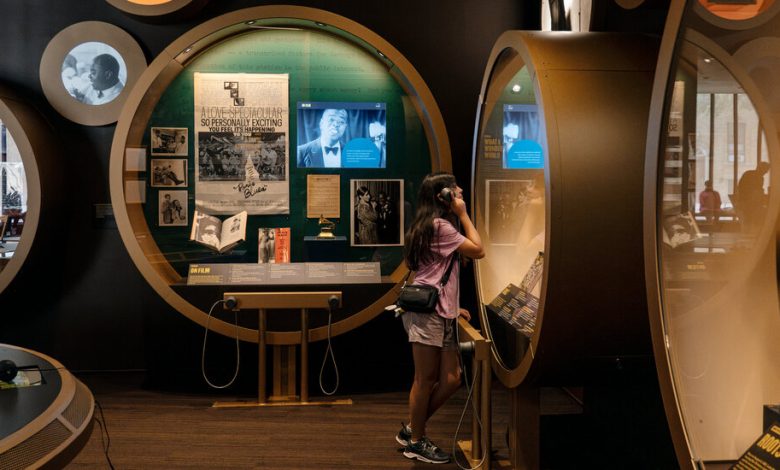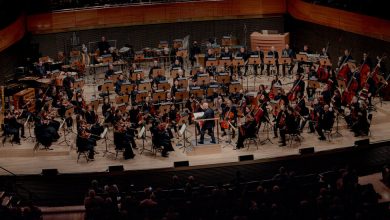Secret No More: Louis Armstrong Center Amplifies Satchmo’s Vision

You can find anything in Queens. And yet for decades, the Louis Armstrong House Museum has been a well-kept secret on a quiet street in Corona. The longtime residence of the famed jazz trumpeter, singer and bandleader, it is a midcentury interior design treasure hidden behind a modest brick exterior.
The museum’s new extension, the 14,000 square foot Louis Armstrong Center, blends in a little less. It looks, in fact, a bit like a 1960s spaceship landed in the middle of a residential block. By design, it doesn’t tower over its neighboring vinyl-sided houses but, with its curvilinear roof, it does seem to want to envelop them. And behind its rippling brass facade lie some ambitious goals: to connect Armstrong as a cultural figure to fans, artists, historians and his beloved Queens community; to extend his civic and creative values to generations that don’t know how much his vision, and his very being, changed things. It wants, above all, to invite more people in.
“The house is relatively small,” said Regina Bain, executive director of the House Museum and Center, speaking of the two-story dwelling where Armstrong lived with his wife, Lucille, from 1943 until his death in 1971.“But his legacy is humongous. And this is the building that will help us to launch that.”
The Center, 25 years in development, includes exhibition, research and education areas, and, for events, a 75-seat performance space whose blond wood and intimacy recall Dizzy’s Club Coca-Cola, the Jazz at Lincoln Center venue.
“I think that this will do something that we haven’t quite seen in a jazz space,” said Jason Moran, the jazz pianist and composer, who was the Center’s inaugural exhibition curator. “That’s also something that my community needs to witness, too. It needs to watch, how can we take care of an artist’s history? And what else can it unleash in a community that might not even care about the art, but might care about something else related to it? Armstrong gives us all those opportunities to do that.”
For the architects, Sara Caples and Everardo Jefferson, the project was a puzzle in how to link two structures — the Center is across the street from the Armstrong House Museum — with the spirit of a musical legend. Their inspiration came by going back to the music, and to Armstrong’s street-level roots. “That kind of neighborhood that jazz actually emerged from — that wasn’t an elite creation, it was a popular creation,” Caples said. “And yet it was the music that revolutionized how we think, how we listen, how we think about nonmusical things, even.” They rounded the front of the Center to nod to the Armstrong house; its brass curtain echoes the color of his horn, and — the musically fluent may notice — the staggered hoop-shapes and columns in the entryway map out the notes of his most celebrated songs, like “What a Wonderful World” and “Dinah.”
They also wanted to give their blueprint the sense of joy that Armstrong brings, the smile that you can feel in his singing voice. When they started the project, Jefferson called an uncle who’s a jazz saxophonist to ask — really, what made Armstrong so special? “And he said, you know, when you hear his music, you feel like dancing down the street,” Jefferson said.
At the ribbon-cutting ceremony earlier this summer, trumpeters performed on the Armstrong house balcony and, across the road, on the upper deck of the Center, a fanfare that started with the opening bars of “West End Blues” and ended with “It’s a Wonderful World.” “It was an incredible moment — the building participated as a reflector of sound back to the street,” Caples said. Afterward, schoolchildren were invited in to plonk around on a Steinway.
Built on the site of a former parking lot, with $26 million in mostly state and local funding, the new Center encompasses Armstrong’s 60,000-piece archive, including 700 tapes that were once housed miles away at Queens College. From that collection, Moran has curated the first permanent exhibition, “Here to Stay,” with a multimedia, interactive centerpiece of audio, video, interviews and songs. There’s Armstrong’s gold-plated trumpet — a gift from King George V — complete with his favorite imported German lip balm and the mouthpiece inscribed “Satchmo,” his nickname — and his collage art. (He made hundreds of pieces, paper cutouts on tape cases.) His first and last passports, among the ephemera, show his evolution from New Orleans-born youth player to a global icon in a tuxedo and an irrepressible grin.
Armstrong was himself a documentarian, traveling with cameras and recording equipment and turning the mic on himself, his friends and loved ones in private moments — telling jokes backstage, opining at home. As a Black artist with an elementary school education, who was born into segregation, he went on to hobnob with presidents and royalty and to meet the pope. “He really marks a way of being a public figure,” Moran said. “And he has to weigh how he does that. If he’s getting a chance not only to tell his story with his trumpet in his mouth but through these microphones, then what are the stories he wants to tell, not in public? Those become important.”
One place his vision is most evident is in his reel-to-reel tape box collages, rarely displayed publicly until now. Armstrong used them as an outlet for years.
“If he has a press clipping, maybe it wasn’t favorable, he could cut it up and make a collage,” Moran said. A photo in the exhibition shows him, after a trip to Italy, pasting his art work on the ceiling of his den, fresco-style. (Lucille Armstrong, a former Cotton Club dancer who was his fourth wife, put a stop to that.)
Moran recalled that when Armstrong talked about his process and why he liked making collages, he explained that with just the push-pull of material on a small canvas, you can change “the story that you were given.” It echoed his expertise as a musician, Moran said, learning how to play background, on the cornet, with King Oliver, his early mentor, or foreground as he redefined what it meant to be a soloist, upending his destiny along the way.
The exhibition also has the artist Lorna Simpson in a video reflecting on Armstrong’s collages and how they compartmentalized an enormous and complex life into the manageable and portable square of a tape case. “Armstrong archives and recontextualizes his public life by hand, to be layered and collaged onto the walls of his private life,” she said.
The gallery display (by C & G Partners) is full of circular motifs, reminiscent of musical notes or records. In determining the palette for the Center, Jefferson and Caples, the architects, looked at Armstrong’s art and his wardrobe; his home, with rooms in shades of electric blue or creamy peach, was mostly styled by Lucille. But he loved it — especially the spaces with gilded or reflective surfaces. “So it gave us the cue that we should not be too mousy,” Caples said, “and that this was a public building where there could be some expansiveness.” The club space at the Center, which recently hosted a rehearsal of trumpeters for the Newport Jazz Festival’s Armstrong tribute — taking place this weekend in Rhode Island — is a vibrant red.
Moran made sure there was a book from the Armstrongs’ vast collection in every vitrine. “They had that kind of political library that was investigating their role in society,” he said. (They also were creatures of their era: The full archives include Playboy anthologies and vintage diet recipes; a guide called “Lose Weight the Satchmo Way” — heavy on the lamb chops — is displayed in the exhibition.)
Even a longtime Armstrong devotee like Marquis Hill, one of the Newport trumpeters, was moved by these personal mementos. (He snapped a picture of the handwritten recipe for Armstrong’s favorite dish, red beans and rice.) A half-century-old recording of Armstrong discussing how important it was to listen to all kinds of music inspired a Hill compositionfor Newport, commissioned by the Center. Its jazz club, he said, is “going to be a new space for what Louis Armstrong wanted, to keep pushing the music forward.”
As part of an artist in residence program this fall, the Grammy winning bassist and singer Esperanza Spalding will present her project with the choreographer Antonio Brown that explores the era when people danced to jazz. Rooting herself in Armstrong’s history, and expanding his vision, Spalding said in an email, would “develop ways to re-merge and re-awaken the dialogue between these essential modalities of human expression — the improvising body and the improvising musician.”
Under Bain, the executive director,the Center is also hosting new programming, including dance and yoga classes, trumpet lessons and events that engage the mostly Spanish-speaking community, whether through music or social activism.
“Louis and Lucille were two Black artists who owned their own home in the ’40s,” Bain said. “Why can’t we have a workshop here about homeownership for our neighbors? If it’s in the legacy of Louis and Lucille — that’s what this space can also be.”
Since it opened on July 6, the Center has exceeded visitor estimates and is adding more hours and drawing fans from across the country. “He was one of the heroes I was taught about,” said Jenne Dumay, 32, a social worker from Atlanta who plans music-oriented trips with friends, focusing on Black history. “This museum gives me insight that I didn’t learn in my textbooks.”
Among the final work Armstrong created, after a lengthy hospital stay in 1971, was a six-page handwritten ode to Corona, and his happy, quotidian life there. In looping script, he extols the virtues of his Schnauzers as watch dogs (“When the two start barking together — oh boy, what a duet”), and his favoriteChinese restaurant.
It is one of the treasures that Moran — who said Armstrong’s spirit-lifting music helped him through the pandemic — cherishes most. Armstrong’s handwriting, he noted, slants upward on every page. “The text is just so inherently aspirational,” Moran said. “It’s in line with how he holds his trumpet” — pointing up to the sky — “how his eyes look when he plays. It’s a slight thing, but it tells us: this is how he thinks about life.”
Additional reporting by Chris Kuo.
The Louis Armstrong Center
34-56 107th Street, Queens, N.Y.; 718-478-8271; louisarmstronghouse.org.



